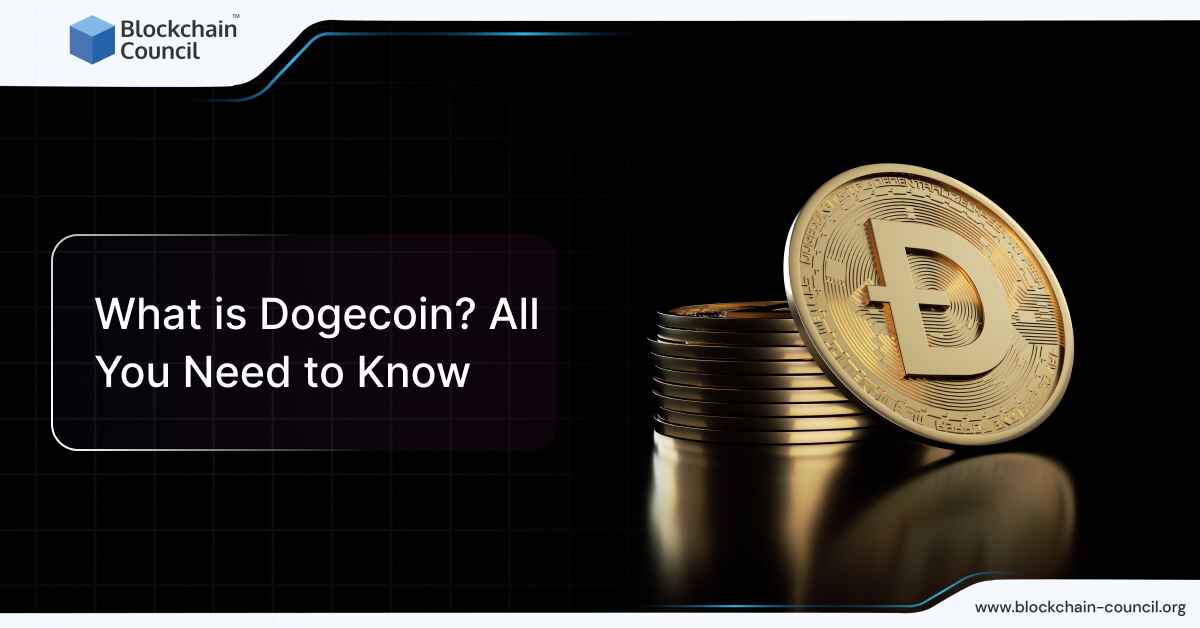
- Blockchain Council
- September 02, 2024
Summary
- Dogecoin, initially a lighthearted project, has evolved into a prominent cryptocurrency recognized worldwide, symbolized by the iconic Shiba Inu dog meme.
- Unlike other digital currencies with specific purposes, Dogecoin was created to spread joy and humor in the crypto community, garnering widespread acceptance and support.
- The history of Dogecoin traces back to its launch in 2013 by Billy Markus and Jackson Palmer, aiming to be more accessible and fun than Bitcoin.
- Notable endorsements from celebrities like Elon Musk propelled Dogecoin to unprecedented levels of attention in 2021, leading to increased adoption and recognition.
- Dogecoin operates on Blockchain technology, utilizing a proof-of-work consensus mechanism to validate transactions and secure the network.
- The mining process of Dogecoin involves solving cryptographic puzzles, with miners rewarded for their efforts, contributing to the coin’s circulation and security.
- Despite its playful origins, Dogecoin’s utility has expanded through partnerships with brands like Gucci and platforms like Wag!, showcasing real-world applications beyond online transactions.
- However, criticisms regarding sustainability, security, and utility persist, raising concerns about Dogecoin’s valuation and over-dependence on celebrity endorsements.
- The future of Dogecoin remains uncertain, with debates over its legitimacy, potential utility, and regulatory impact shaping its trajectory in the cryptocurrency landscape.
- Nonetheless, with ongoing developments and increased acceptance, Dogecoin continues to hold promise, demonstrating resilience and adaptability in the ever-changing digital currency space.
Dogecoin, once started as a playful project, has now become one of the most recognized cryptocurrencies in the digital finance world. This digital currency, symbolized by the Shiba Inu dog from the “Doge” meme, has captured the imagination of investors, tech enthusiasts, and the general public alike. Unlike other digital currencies designed with a specific purpose, Dogecoin was created to spread cheer and fun in the crypto community. However, its widespread acceptance and the enthusiastic support from its community have propelled Dogecoin from a meme to a legitimate payment and investment option. This article explores everything you need to know about Dogecoin. We will explore what Dogecoin is, its origins, how it works, why it’s gained popularity, and whether it’s a wise investment choice.
What is Dogecoin?
Dogecoin (DOGE) is a peer-to-peer, open-source cryptocurrency. It’s considered an altcoin and a meme coin. Unlike other digital currencies designed with a specific purpose, Dogecoin was created to spread cheer and fun in the crypto community. However, its widespread acceptance and the enthusiastic support from its community have propelled Dogecoin from a meme to a legitimate payment and investment option. This article explores everything you need to know about Dogecoin, from its inception to its current status in the cryptocurrency world.
The History of Dogecoin: From Meme to Cryptocurrency
- 2013: Dogecoin was launched by Billy Markus and Jackson Palmer. It was intended to be fun and more accessible than Bitcoin.
- 2014-2015: The community funded several charitable and promotional projects, including the Jamaican Bobsled Team’s trip to the Sochi Winter Olympics and a NASCAR sponsorship.
- 2021: Dogecoin gained unprecedented attention, partly due to endorsements from celebrities like Elon Musk, Snoop Dogg, and others.
- 2023: Dogecoin continues to grow, with increased adoption as a payment method by various merchants and companies.
- 2024: As of early 2024, Dogecoin’s price has shown signs of recovery, rallying significantly from its cycle low. This resurgence is attributed to the community’s strength, celebrity endorsements, and its growing use as a payment method.
Also Read: What are Agents in Artificial Intelligence (AI)?
Dogecoin VS Bitcoin: Key Differences
| Feature | Dogecoin | Bitcoin |
| Creation | Created as a joke in 2013 | Created by Satoshi Nakamoto in 2009 |
| Purpose | Originally intended as a meme currency | Designed as a decentralized digital currency |
| Supply Cap | No maximum supply | Capped at 21 million coins |
| Transaction Speed | Faster block time (1 minute) | Slower block time (around 10 minutes) |
| Market Cap | Generally smaller than Bitcoin | Largest market cap among cryptocurrencies |
| Community | Known for its vibrant and enthusiastic community | Has a strong and diverse community of users and developers |
| Price Volatility | Often experiences higher volatility | Generally less volatile compared to altcoins |
| Acceptance | Accepted by some merchants and platforms | Widely accepted as a form of payment |
How Does Dogecoin Work?
Dogecoin operates on Blockchain technology, allowing it to run without a central authority, similar to other cryptocurrencies like Bitcoin and Litecoin. Dogecoin uses a proof-of-work consensus mechanism, requiring miners to solve complex mathematical problems to validate transactions and secure the network. Miners are rewarded with Dogecoin for their efforts, contributing to the coin’s circulation and security.
Technical Foundations of Dogecoin: Blockchain and Decentralization
At its core, Dogecoin’s Blockchain technology enables a decentralized network where transactions are confirmed by community participants, known as miners. This approach ensures that Dogecoin operates in a trustless and secure manner, with its proof-of-work system deterring fraudulent activities and ensuring the integrity of the transaction ledger.
The Mining Process of Dogecoin
Mining Dogecoin involves using computer hardware to solve cryptographic puzzles. This process adds new transactions to the Dogecoin Blockchain and secures the network. Miners are rewarded with Dogecoin, encouraging participation and investment in the network’s infrastructure. Dogecoin mining is accessible through various methods, including solo mining, pool mining, and cloud mining, each with its own set of advantages and considerations. While solo mining offers full control and ownership of rewards, it requires significant resources. Pool mining combines resources for a better chance at rewards, albeit shared among participants. Cloud mining, on the other hand, offers a hands-off approach by renting mining power from a third party.
Mining Dogecoin uses the Scrypt algorithm, which is less energy-intensive than Bitcoin’s SHA-256 algorithm, making it more accessible to individuals without specialized hardware. However, it’s important to note that the profitability of mining Dogecoin can vary widely based on factors such as the current price of Dogecoin, the cost of electricity, and the efficiency of the mining hardware used.
Also Read: Top 10 Artificial Intelligence (AI) Tools for LinkedIn in 2024
How and Where to Buy Dogecoin (Step by Step Guide)
Buying Dogecoin has become more accessible over the years. Here’s a simplified process:
- Choose an Exchange: Select a reputable cryptocurrency exchange like Binance, Bitpanda, Uphold, eToro, Kraken, Changelly, Gemini, or Coinbase. These platforms offer different methods to buy Dogecoin, including direct purchase with fiat currencies (USD, EUR, GBP) or trading other cryptocurrencies for Dogecoin.
- Create an Account: Register on your chosen exchange by providing your personal information and completing any required verification processes to enhance security and increase withdrawal limits.
- Make a Deposit: You can fund your account in various ways, such as depositing cryptocurrency you already own, making a bank transfer, or using a credit or debit card. Some exchanges may offer additional options like PayPal for funding your account, though this is less common for buying Dogecoin directly.
- Buy Dogecoin: After funding your account, search for Dogecoin (DOGE) on the exchange and decide how much you want to buy. You can place a market order for immediate purchase at the current price or use a limit order to specify the price at which you’re willing to buy. Confirm your purchase details and complete the transaction.
Storing Your Dogecoin: Wallet Options
Once you have Dogecoin, you’ll need a secure place to store it. There are two main types of wallets:
- Hardware Wallets: These are physical devices that store your cryptocurrency offline, making them very secure. Popular options include the Ledger Nano S, Nano X, TREZOR One, and TREZOR Model T. These wallets support Dogecoin and other cryptocurrencies.
- Software Wallets: These wallets run on your computer or smartphone, storing your private keys digitally. Examples include MultiDoge, a Doge-specific wallet, and multi-currency wallets like Exodus and Coinomi. While convenient, they can be vulnerable to malware, so it’s crucial to download them from official or reputable sources.
With its distinctive Shiba Inu logo and a strong, supportive community, Dogecoin has transcended its meme origins to become a notable digital asset. Despite its playful beginnings, Dogecoin has witnessed substantial growth, engaging a wide audience from casual users to prominent figures like Elon Musk.
Also Read: Comparing Different Types of Artificial Neural Networks
Collaborations, Partnerships, and Real-World Use Cases
Dogecoin’s utility and acceptance have expanded through various collaborations and partnerships, marking its entry into real-world applications:
- Fashion Industry: A notable example is the luxury fashion brand Gucci announcing it would accept Dogecoin among other cryptocurrencies as a payment method at select retail outlets. This move by Gucci signifies a growing trend of cryptocurrency adoption in the retail sector, showcasing Dogecoin’s potential beyond online transactions.
- Service Industry: Dogecoin has also made strides in the service industry. For instance, the on-demand dog-walking app Wag! integrated Dogecoin payments, allowing pet owners to pay for services like dog walks and overnight stays using Dogecoin. This integration not only broadens Dogecoin’s use case but also highlights its practical value in everyday services.
- Environmental Initiatives: Wag! has taken a step further by committing a percentage of its crypto-related revenue to environmentally friendly charities. This aligns with the broader crypto community’s growing concern for sustainability, especially considering the environmental impact of cryptocurrency mining.
- Sports: One notable example of Dogecoin’s real-world application is its acceptance by the Dallas Mavericks, an NBA team owned by entrepreneur Mark Cuban. The team accepts Dogecoin as payment for tickets and merchandise, showcasing Cuban’s commitment to providing diverse payment options and highlighting the increasing acceptance of Dogecoin in the sports world.
- Financial Services: The platform X (formerly known as Twitter), under Elon Musk’s leadership, has expressed interest in incorporating Dogecoin into its planned full payment and banking services. This potential integration could significantly elevate Dogecoin’s status and utility, providing a platform for wider acceptance and use in financial transactions.
Criticisms of Dogecoin: Sustainability, Security, and Utility
Dogecoin, despite its popularity and significant market presence, faces several criticisms primarily concerning its sustainability, security, and utility. Critics argue that Dogecoin’s valuation is difficult to justify when compared to tangible companies with substantial revenues and assets. For instance, if Dogecoin were to reach a $1 valuation, its market cap would rival that of major global firms, a scenario some find unrealistic given its limited real-world applications.
Moreover, Dogecoin’s reliance on Elon Musk for its price movements and public perception is another point of contention. While Musk’s support has undeniably boosted Dogecoin’s profile, it has also led to criticisms of over-dependence on celebrity endorsements rather than solid fundamentals or technological advancements.
The Debate Over Dogecoin’s Legitimacy and Future
The future and legitimacy of Dogecoin are subjects of much debate within the cryptocurrency community. On one side, proponents highlight its strong community support and growing use cases, such as its adoption by major brands like Gucci and platforms like Wag! for payments. On the other hand, skeptics question whether these developments are enough to sustain long-term growth and overcome the inherent challenges of high concentration among few holders and lack of significant innovation or differentiation from other cryptocurrencies.
Dogecoin’s mining aspect, which operates on a proof-of-work mechanism, is cited as both a strength, due to its security benefits, and a potential drawback, considering the environmental concerns associated with cryptocurrency mining. The debate extends to Dogecoin’s potential utility and adoption, with some viewing its expansion into services like X’s financial platform as a positive step towards mainstream acceptance.
Also Read: Top 10 Artificial Intelligence (AI) Tools for Customer Support and Chatbots in 2024
The Future of Dogecoin
The Dogecoin Foundation, driving the project’s development, has outlined its first-ever roadmap. This strategic plan includes several initiatives aimed at enhancing Dogecoin’s utility and adoption. Key projects highlighted in the roadmap are:
- LibDogecoin: A foundational C library for building Dogecoin applications, making it easier for developers to integrate Dogecoin functionalities into their projects.
- GigaWallet: A scalable backend solution designed to facilitate the integration of Dogecoin transactions into various platforms quickly and efficiently.
- Dogecoin Standard: A project focused on defining a comprehensive standard for Dogecoin, essentially serving as a detailed documentation to aid understanding and development within the Dogecoin ecosystem.
- Community Staking Proposals: Collaborating with Ethereum’s founder, Vitalik Buterin, the Dogecoin Foundation is exploring a uniquely Doge approach to proof of stake that emphasizes community participation and rewards.
The Potential Impact of Regulatory Changes on Dogecoin
Regulatory changes in the cryptocurrency landscape could significantly impact Dogecoin, as with other cryptocurrencies. Stricter regulations might introduce challenges related to compliance and operational flexibility. Conversely, clear and supportive regulatory frameworks could foster wider adoption and integration of Dogecoin in financial systems and services.
Analysts are optimistic about Dogecoin’s future. Predictions based on AI models forecast a substantial price increase, possibly up to 305% before the 2024 Bitcoin halving event, driven by factors like increased institutional adoption and technical upgrades enhancing Dogecoin’s utility and performance.
Conclusion
Dogecoin’s journey from a playful project to a significant player in the crypto market underscores the unpredictable nature of digital currencies. It has shown resilience and adaptability, gathering a large, dedicated community. With ongoing developments and increased acceptance, Dogecoin’s future looks bright, even as it faces challenges common to cryptocurrencies, such as volatility and regulatory scrutiny. Whether for investment, tipping online, or buying goods and services, Dogecoin continues to hold its place in the digital currency space.
Frequently Asked Questions
- What is Dogecoin?
- Dogecoin is a peer-to-peer, open-source cryptocurrency.
- It features the face of the Shiba Inu dog from the “Doge” meme as its logo.
- Initially created as a joke, it is now used for tipping and donations.
- How does Dogecoin work?
- Dogecoin works using Blockchain technology, similar to Bitcoin and Ethereum.
- Transactions are verified by a decentralized network of computers (miners) and recorded in a public ledger.
- It uses a proof-of-work consensus mechanism.
- Can Dogecoin be used for purchases?
- Yes, Dogecoin can be used for online tipping, donations, and purchasing goods and services where it is accepted.
- Its acceptance is growing among merchants and service providers.
- What makes Dogecoin different from other cryptocurrencies?
- Dogecoin has a strong, vibrant community that emphasizes generosity and humor.
- Unlike Bitcoin, there is no cap on the total supply of Dogecoins, leading to inflationary dynamics.
- It was created without a serious purpose but has gained legitimacy over time.
- Where can you buy Dogecoin?
- Dogecoin can be purchased on various cryptocurrency exchanges such as Binance, Coinbase, and Kraken.
- Users must set up a digital wallet to store Dogecoin.
- It can be traded for other cryptocurrencies or bought using fiat currencies like USD, EUR, etc.





































































 Guides
Guides News
News Blockchain
Blockchain Cryptocurrency
& Digital Assets
Cryptocurrency
& Digital Assets Web3
Web3 Metaverse & NFTs
Metaverse & NFTs
